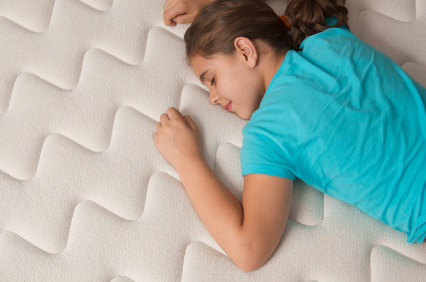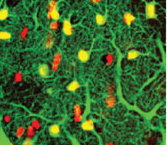Guanfacine Augments Stimulants in ADHD
Tim Wilens of Massachusetts General Hospital presented a poster at the 57th Annual Meeting of the American Academy of Child and Adolescent Psychiatry (AACAP) in October 2010 that showed that extended release guanfacine could augment incomplete responses to stimulants in children with attention deficit hyperactivity disorder (ADHD). This double-blind, placebo-controlled study of children aged 6-17 used guanfacine doses of 4mg/day or less. Those children who received guanfacine in addition to the psychomotor stimulant they were already taking were more likely to improve and more likely to reach a satisfactory remission than those taking a placebo in addition to their regular psychomotor stimulant. These results suggest that adding an alpha 2 noradrenergic agonist compound like guanfacine to a psychomotor stimulant may bring about a more complete response in ADHD.
Vitamin D Deficiency Found in Adolescents with Serious Mental Disorders
 Barbara Gracious of the University of Rochester Medical Center reported at the 57th Annual Meeting of the American Academy of Child and Adolescent Psychiatry (AACAP) in October 2010 that adolescents with severe mental illness are more likely to have vitamin D deficiency than adolescents in the general population are. Gracious et al. collected information from severely mentally ill teens in inpatient and day hospital settings. Low vitamin D levels (i.e. those below 30 ng/ml) were found in 74% of these children. In addition, those patients who were vitamin D deficient were more than three times as likely to have a psychotic element to their illness.
Barbara Gracious of the University of Rochester Medical Center reported at the 57th Annual Meeting of the American Academy of Child and Adolescent Psychiatry (AACAP) in October 2010 that adolescents with severe mental illness are more likely to have vitamin D deficiency than adolescents in the general population are. Gracious et al. collected information from severely mentally ill teens in inpatient and day hospital settings. Low vitamin D levels (i.e. those below 30 ng/ml) were found in 74% of these children. In addition, those patients who were vitamin D deficient were more than three times as likely to have a psychotic element to their illness.
Editor’s note: These data suggest the potential importance of assessing vitamin D levels during the diagnosis of patients with childhood-onset bipolar disorder, particularly if there is associated psychotic symptomatology.
A Suggested Dosing Regimen for Lithium in Children
At the 57th Annual Meeting of the American Academy of Child and Adolescent Psychiatry (AACAP) in October 2010, Bob Findling of Case Western Reserve University reported finding a 58% response rate to lithium in children with bipolar I disorder. He explored three different dosing regimens, and recommends starting children off with 300mg capsules TID (three times a day) for a total of 900 mg/day, and then increasing by a single 300mg capsule every week until there is a good effect or until side effects emerge. The most typical side effects that he saw were headache, nausea, and vomiting.
Starting at a relatively high initial dose of 900mg/day is consistent with the finding that even high doses of lithium are absorbed and transferred into the brain quite slowly. This loading approach appears to be an excellent strategy for rapidly achieving the blood levels necessary for optimal therapeutics in young children. Findling also suggests that an upper limit of blood levels as high as 1.4 mEq/l is acceptable in children because, in his experience, children often appear to need higher doses and blood levels than do adults.
Dosing and Efficacy of Ziprasidone in Adolescents
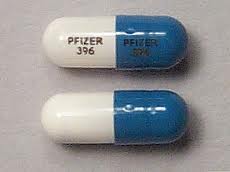 At the 57th Annual Meeting of the American Academy of Child and Adolescent Psychiatry (AACAP) in October 2010, Kirti Saxena of Dallas, Texas described a small pilot study that compared rapid- and slow-dose titration of ziprasidone in adolescent patients with bipolar disorder. Both slow and rapid methods of increasing doses resulted in effective treatment of acute manic symptoms, with rapid dose increases achieving improvement slightly faster.
At the 57th Annual Meeting of the American Academy of Child and Adolescent Psychiatry (AACAP) in October 2010, Kirti Saxena of Dallas, Texas described a small pilot study that compared rapid- and slow-dose titration of ziprasidone in adolescent patients with bipolar disorder. Both slow and rapid methods of increasing doses resulted in effective treatment of acute manic symptoms, with rapid dose increases achieving improvement slightly faster.
Editor’s Note: Given the data from patients with schizophrenia that higher doses of ziprasidone are better tolerated than lower doses, rapid dose titration toward 160mg/day or higher in manic patients may be best, because low doses can be associated with agitation or excitation in some patients.
If ziprasidone is being used, it is important that it is taken with food and not on an empty stomach, because its bioavailability and ability to increase blood levels is highly dependent on its being absorbed with food. The variability of ziprasidone’s effectiveness based on whether it is taken with food might explain some inconsistencies in the findings on ziprasidone in the treatment of some syndromes.
Two potential concerns about ziprasidone are worth noting. 1) It has not been approved by the Federal Drug Administration (FDA) for the treatment of acute mania in children or adolescents, even though the placebo-controlled trials were positive. A further review of the data by the FDA is pending. 2) The drug is associated with prolongation of the QTC interval, a measure of electrical activity in the heart. Such a prolongation theoretically predisposes patients to cardiac arrhythmias. However, in clinical follow up studies in adults and children, this has not proven to be problematic, and a study comparing 9,000 adults on olanzapine (which does not increase the QTC interval) and ziprasidone (which does) showed equal degrees of adverse cardiovascular events.
Ziprasidone is clearly worthy of consideration for treating adolescents, because it does not cause weight gain, nor does it increase any of the metabolic indices, such as cholesterol, triglycerides, blood glucose, or insulin resistance, as seen with some of the other atypical antipsychotics. Ziprasidone has recently been FDA-approved as an adjunct to lithium or valproate in prophylactic treatment of adult bipolar disorder.
Quetiapine (Seroquel) May Be Effective in Childhood Mania
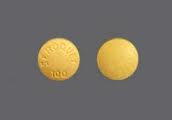 Gagan Joshi performed an 8-week open study of quetiapine in 30 preschool children and 19 school-age children. The mean dose was 176 mg/day on average for the preschool children, and 248 mg/day for the school age children, and both appeared highly effective in treating manic symptomatology. At the 57th Annual Meeting of the American Academy of Child and Adolescent Psychiatry (AACAP) in October 2010, Joshi reported that while the drug was generally well tolerated, it was associated with significant weight gain; the preschoolers gained 3.1 lbs on average in the 8-week period, while the school age children gained an average of 7.4 lbs.
Gagan Joshi performed an 8-week open study of quetiapine in 30 preschool children and 19 school-age children. The mean dose was 176 mg/day on average for the preschool children, and 248 mg/day for the school age children, and both appeared highly effective in treating manic symptomatology. At the 57th Annual Meeting of the American Academy of Child and Adolescent Psychiatry (AACAP) in October 2010, Joshi reported that while the drug was generally well tolerated, it was associated with significant weight gain; the preschoolers gained 3.1 lbs on average in the 8-week period, while the school age children gained an average of 7.4 lbs.
Activity Monitoring Discriminates Between BP Kids and ADHD Kids
At the 57th Annual Meeting of the American Academy of Child and Adolescent Psychiatry (AACAP) in October 2010, Gianni Faedda of the Lucio Bini Mood Disorders Center reported that monitoring of activity, sleep, and circadian-rhythm disturbances can be used to distinguish children with a diagnosis of bipolar illness (who showed more hyperactivity and less sleep), from children with ADHD and control children without illness.
Thyroid Abnormalities Common in Childhood Mental Illness
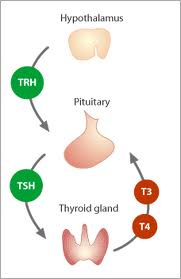 At the 57th Annual Meeting of the American Academy of Child and Adolescent Psychiatry (AACAP) in October 2010, Maria Gariup of Barcelona, Spain reported that thyroid abnormalities are common among children with major psychiatric diagnoses and, in particular, high levels of thyroid stimulating hormone (TSH) are common among those with bipolar illness.
At the 57th Annual Meeting of the American Academy of Child and Adolescent Psychiatry (AACAP) in October 2010, Maria Gariup of Barcelona, Spain reported that thyroid abnormalities are common among children with major psychiatric diagnoses and, in particular, high levels of thyroid stimulating hormone (TSH) are common among those with bipolar illness.
Editor’s Note: These findings may relate to reports of a greater incidence of anti-thyroid antibodies in adult patients with bipolar disorder compared with many other psychiatric groups.
Lower Blood Iron Levels Linked to More Severe ADHD
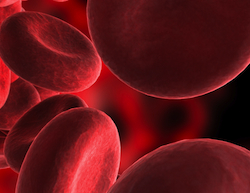 At the 57th Annual Meeting of the American Academy of Child and Adolescent Psychiatry (AACAP) in October 2010, Chadi Calarge of the University of Iowa’s Carver College of Medicine reported that among children with attention-deficit hyperactivity disorder (ADHD), blood iron levels were inversely correlated with the severity of ADHD symptoms. That is, those with lower iron levels in their blood had greater severity of ADHD symptomatology and, in addition, required higher doses of stimulants to achieve effective results.
At the 57th Annual Meeting of the American Academy of Child and Adolescent Psychiatry (AACAP) in October 2010, Chadi Calarge of the University of Iowa’s Carver College of Medicine reported that among children with attention-deficit hyperactivity disorder (ADHD), blood iron levels were inversely correlated with the severity of ADHD symptoms. That is, those with lower iron levels in their blood had greater severity of ADHD symptomatology and, in addition, required higher doses of stimulants to achieve effective results.
Editor’s note: It would appear clinically useful to check blood iron levels in patients with ADHD symptomatology, particularly when symptoms are severe or when the illness requires very high doses of stimulants to achieve therapeutic effects.
Stress or Ultrasonic Stimulation In Utero Could Alter Neuronal Migration Patterns
At the 57th Annual Meeting of the American Academy of Child and Adolescent Psychiatry (AACAP) in October 2010, Hanna Stevens of the Yale Child Study Center reported that rat pups in utero who experienced prenatal stress (i.e., when the pregnant rat was restrained during the last week of pregnancy) had fewer neurons containing GABA, which is the main inhibitory neurotransmitter in the brain, than control pups. This deficit may reflect a delay in the neurons’ ventral to rostral migration or in their maturation. These deficits in GABAergic neurons following prenatal stress are noteworthy in light of the deficits in GABAergic neurons found in adults with bipolar illness. This research is unusual in that it suggests that prenatal stress can affect neuronal numbers.
Editor’s Note: Stevens was aware of data from the renowned neuroanatomist Pasco Rakic, also at Yale. Some years ago Rakic reported that ultrasonic stimulation of the brain had major disorganizing effects on neuronal migration in the primate brain. Since prenatal stress and ultrasonic stimulation can affect neuronal migration, and dysregulation of neuronal migration has been implicated in autism, these data raise the hypothesis (so far untested) that one possible reason for the recent increases in the incidence of autism is the increased use of sonograms to monitor various aspects of prenatal growth and development during pregnancy. These preclinical findings deserve to be further studied for their potential relevance to humans.
Phosphatidylserine Omega-3 Fatty Acids in ADHD
Iris Manor reported at the 57th Annual Meeting of the American Academy of Child and Adolescent Psychiatry (AACAP) in October 2010 that phosphatidylserine (a phospholipid component) containing omega-3 fatty acids had significant positive effects in children with ADHD. These findings were notable because Manor and other investigators had previously found that omega-3 fatty acids themselves were not effective in ADHD, raising the possibility that the phosphatidylserine component offers unique therapeutic advantages. This compound is currently available in Israel and may become available in the US in the next year.


